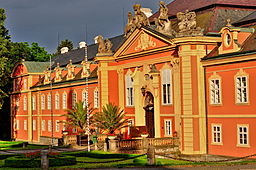Dobříš
| Dobříš | |||
| Town | |||
|
|||
| Country | Czech Republic | ||
|---|---|---|---|
| Region | Central Bohemian | ||
| District | Příbram | ||
| Commune | Dobříš | ||
| Elevation | 371 m (1,217 ft) | ||
| Coordinates | 49°47′0.27″N 14°11′41.71″E / 49.7834083°N 14.1949194°ECoordinates: 49°47′0.27″N 14°11′41.71″E / 49.7834083°N 14.1949194°E | ||
| Area | 53.41 km2 (20.62 sq mi) | ||
| Population | 8,612 | ||
| Density | 161/km2 (417/sq mi) | ||
| First mentioned | 1252 | ||
| Mayor | Jaroslav Melša | ||
| Timezone | CET (UTC+1) | ||
| - summer (DST) | CEST (UTC+2) | ||
| Postal code | 263 01 | ||
| Website: www.mestodobris.cz | |||
Dobříš (Czech pronunciation: [ˈdobr̝iːʃ]; German: Doberschisch) is a town in the Central Bohemian Region of the Czech Republic with about 8,600 inhabitants. It is the second largest town in Příbram District, located 40 km (25 mi) south of Prague. It is part of the Prague metropolitan area.
The settlement on the Golden Path trade route was first mentioned when in 1252 King Wenceslaus I of Bohemia signed a treaty with the Cistercian abbey of Plasy. Temporarily held by the noble House of Rosenberg, King John the Blind had a hunting lodge erected at Dobříš, which received town privileges by his grandson King Wenceslaus IV. It was devastated during the Hussite Wars in 1421.
After the Kingdom of Bohemia had passed to the Habsburg Monarchy, Dobříš was given further city rights by King Ferdinand I in 1543, confirmed by his son and successor Emperor Maximilian II in 1569. Dobříš Castle was acquired by the German House of Mansfeld in 1630, who had it rebuilt in a Rococo style from 1745 onwards. It was inherited by the Austrian Colloredo-Mansfeld dynasty in 1780.
...
Wikipedia





